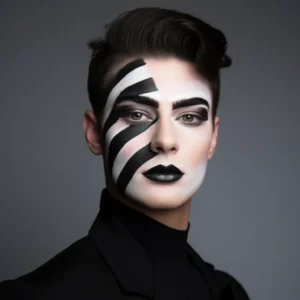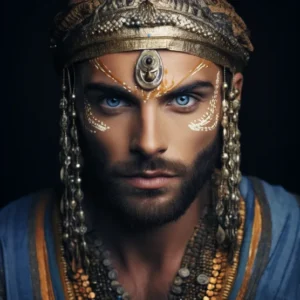Introduction:
The evolution of men’s makeup is a fascinating journey that spans centuries, reflecting societal shifts, cultural influences, and changing perceptions of beauty. From ancient civilizations to contemporary times, men have consistently engaged with cosmetics as a means of self-expression, identity, and empowerment. This timeline explores key trends and movements that have shaped the landscape of men’s makeup, highlighting its transformative journey through history.
Ancient Civilizations (4000 BCE – 476 CE):
4000 BCE – Mesopotamia:
- Men and women in Mesopotamia use kohl, a dark powder made from lead sulfide, for eye embellishment. The application of makeup becomes a symbol of social status.
3000 BCE – Egypt:
- Egyptian men, particularly pharaohs, use black eyeliner made from minerals like galena and malachite. Makeup becomes intertwined with spirituality, symbolizing protection and good health.
5th Century BCE – Greece:
- The Greeks embrace cosmetics, considering it a sign of refinement. Men use powders and pigments to enhance their features, aligning their appearance with the ideals of classical art.
Medieval and Renaissance (476 CE – 1600 CE):
12th Century – Islamic Golden Age:
- Persian and Arab cultures contribute to the art of perfumery and cosmetics. Men use scented oils and aromatic substances for grooming.
15th Century – Renaissance:
- The Renaissance witnesses a resurgence of makeup. Pale skin is in vogue, and both men and women use lead-based cosmetics for a fair complexion. Aristocrats don elaborate makeup as a symbol of status.
17th to 19th Century:
17th Century – Rococo Era:
- The extravagant Rococo era sees European men adorning themselves with powdered wigs and makeup. Makeup becomes a visible marker of aristocratic elegance.
19th Century – Victorian Restraint:
- The Victorian era brings a decline in the acceptance of men’s makeup in everyday life due to conservative values. However, discreet cosmetic practices persist.
Early to Mid-20th Century:
1920s – Hollywood Influence:
- The glamour of Hollywood introduces a new era of makeup acceptance. Actors, including men, embrace cosmetics both on and off the screen, influencing beauty standards.
1960s – Counterculture Movements:
- The Beat Generation and hippie movement challenge traditional norms. Men in these subcultures experiment with makeup, expressing anti-establishment sentiments.
Late 20th Century:
1980s – Glam Rock and New Wave:
- Musicians in the Glam Rock and New Wave movements, like David Bowie and Boy George, redefine masculinity with bold and androgynous makeup looks.
1990s – Grunge Aesthetic:
- The grunge movement rejects conventional beauty standards. Men embrace a minimalist aesthetic, often opting for a natural and unpolished appearance.
21st Century:
Early 2000s – Metrosexual Trend:
- The term “metrosexual” gains popularity, reflecting a cultural shift where men actively engage in grooming and beauty routines without conforming to traditional gender norms.
2010s – Rise of Male Beauty Influencers:
- Social media platforms enable the rise of male beauty influencers who challenge stereotypes, showcase diverse makeup styles, and encourage men to embrace beauty as a form of self-expression.
Present Day – Inclusivity and Mainstream Integration:
- The beauty industry actively embraces inclusivity, featuring male models in campaigns and expanding product lines. Men’s makeup becomes more integrated into mainstream beauty, challenging traditional gender norms.
Future Trends:
Gender Fluidity and Redefined Masculinity:
- The future holds promise for a more fluid expression of gender and masculinity, where men’s makeup becomes an integral part of mainstream beauty routines, challenging and redefining societal norms.
Technology Integration:
- Advancements in technology, including virtual try-on experiences and augmented reality tools, make makeup more accessible for everyone, providing new avenues for exploration and experimentation.
Conclusion:
The evolution of men’s makeup is a dynamic tapestry woven through time, reflecting the diverse influences and movements that have shaped societal attitudes towards beauty and self-expression. From ancient rituals to modern inclusivity, the journey of men’s makeup is a testament to the enduring desire for personal expression and the breaking down of traditional norms. As we move forward, the narrative of men’s makeup continues to unfold, promising a future where diversity, individuality, and empowerment take center stage in the ever-evolving landscape of beauty.


